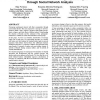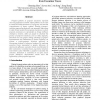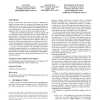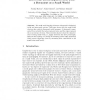178 search results - page 17 / 36 » Representing social structures in UML |
CIKM
2007
Springer
14 years 2 months ago
2007
Springer
Newsgroup participants interact with their communities through conversation threads. They may respond to a message to answer a question, debate a topic, support or disagree with a...
ICTAI
2008
IEEE
14 years 3 months ago
2008
IEEE
Frequent patterns in program executions represent recurring sequences of events. These patterns can be used to reveal the hidden structures of a program, and ease the comprehensio...
IADIS
2004
13 years 10 months ago
2004
MIDAS is a model-driven methodology for Web Information Systems development based on the OMG's Model Driven Architecture. It proposes to use UML to describe different views o...
KDD
2009
ACM
14 years 9 months ago
2009
ACM
In large social networks, nodes (users, entities) are influenced by others for various reasons. For example, the colleagues have strong influence on one's work, while the fri...
JSAI
2001
Springer
14 years 1 months ago
2001
Springer
The small world topology is known widespread in biological, social and man-made systems. This paper shows that the small world structure also exists in documents, such as papers. A...




